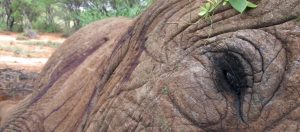
We had begun to think that fearless killing within the reserve boundaries was behind us. Although we had one death in December of last year, it has been nothing compared to the slaughter that occured two years ago; the storm appeared to be clearing. Then came the sad and shocking death of one of our well known bulls: Koitalel (named after Koitalel Arap Samoei, an Orkoiyot, the supreme chief of the Nandi people of Kenya, who led the Nandi rebellion against the British colonial rule).
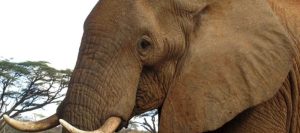
Koitalel alive
On the 28th of March a barrage of gunshots were heard at dusk, south of Buffalo Springs airstrip. On hearing the echoes, a few herders slowly advanced to where the gunshots were. Others got in touch with Nasuulu scouts. When a herd of elephants fled past them, they realized it was not a cattle raid. They immediately called the conservancy warden, codenamed Sierra 1.
STE’s Chris Leadismo was already with the Nasuulu scouts and headed to the scene along with KWS. Community herders guided them in slowly to avoid alerting poachers or being trampled by terrified elephants. At 6:45 they found some blood spots and silently they spread out and began to search for the poachers. Just before the last light disappeared they spotted an elephant standing completely stationary. Immediately they knew that something was wrong. Instead of approaching, they fanned out in an ambush, alerting each other via silent text message that they would wait in the hope that the poachers would return to the elephant to remove his tusks. Helplessly, they watched as the elephant gradually became weaker. Soon he was unable to support himself. Finally he collapsed on his chest, dead. The men then readied themselves in expectation that the poachers would soon come for the tusks. It was going to be a very long night.
The poachers never returned for their bloodied prize. Iain and Frank were airborne soon after first light to search from the air, while I joined rangers from KWS and Buffalo Springs and a team of sniffer dogs from Lewa to start investigating the scene. He was a large bull between 25 and 30 years old, and had been sprayed with 10 gunshots on his right side and three on the left.
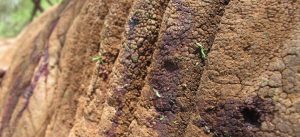
Ten gunshot wounds were sprayed into the body on one side, three on the other
I immediately recognized him as Koitalel, a bull I’ve known for years. He was a big mover in his lifetime, travelling from Kalama deep into Shaba. During this time he’d snapped off one of his tusks and recovered from many injuries, including from an arrow that had been shot in his ear and which he removed himself. But he was no match for automatic gunfire. In his agony, he had attempted to prop himself up in a small tree with his remaining tusk. A tragic scrape mark down the tree bore silent witness to his end.
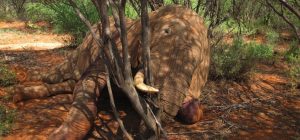
Koitalel tries to jam his tusk high in a tree to support his weight, before finally collapsing
In mourning, we turned back to the hunt for Koitalel’s killers. The search team was very optimistic that they would catch up with the poachers. The sniffer dogs even found the place where they had spent the night. At one point, it appeared that the trail headed towards fresh elephant tracks, as if the poachers were brazen or desperate enough to try and “get lucky” again. However, the search party’s hopes diminished as the tracks headed further east through an area full of livestock and people. The trail was trampled and disappeared.
STE left the scene in the hands of the security forces in the hope that the intelligence team will find information that will lead to the arrests of the culprits. They haven’t been found yet, but it was still encouraging to witness how fast the carefully weaved web of informants and reactors responded: from the herders calling the scouts, to the relay of information from scouts to KWS and us. For our part, STE and our partners are convening a security meeting in the area where we suspect the poachers to be from to try and seek out the culprits through the community and prevent more such tragedies.
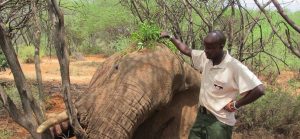
David performes a short Samburu blessing, laying fresh green branches on Koitelel’s head to send him peacefully on his way

